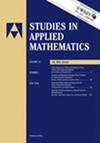Orthogonal Laurent Polynomials of Two Real Variables
IF 2.6
2区 数学
Q1 MATHEMATICS, APPLIED
引用次数: 0
Abstract
In this paper, we consider an appropriate ordering of the Laurent monomials , that allows us to study sequences of orthogonal Laurent polynomials of the real variables and with respect to a positive Borel measure defined on such that . This ordering is suitable for considering the multiplication plus inverse multiplication operator on each variable and , and as a result we obtain five-term recurrence relations, Christoffel–Darboux and confluent formulas for the reproducing kernel and a related Favard's theorem. A connection with the one-variable case is also presented, along with some applications for future research.
两个实变量的正交劳伦多项式
在本文中,我们考虑对劳伦单项式 x i y j $x^{i}y^{j}$ , i , j ∈ Z $i,j (在 \mathbb {Z}$ 中)进行适当排序,从而可以研究实变量 x $x$ 和 y $y$ 的正交劳伦多项式序列,这些序列与定义在 R 2 $\mathbb {R}^2$ 上的正伯勒量 μ $\mu$ 有关,这样 ( { x = 0 }) 。 ∪ { y = 0 } ) ∩ supp ( μ ) = ∅ $(\lbrace x=0 \rbrace \cap \lbrace y=0 \rbrace) \cap \textrm {supp}(\mu)= \emptyset$ 。这种排序适合于考虑每个变量上的乘法加逆乘法算子( x + 1 x $(x+\frac{1}{x}$ 和 y + 1 y ) $ y+\frac{1}{y})$ ,因此我们得到了五项递推关系、重现核的克里斯托弗-达尔布和汇合公式以及相关的法瓦尔德定理。我们还介绍了与一变量情况的联系,以及未来研究的一些应用。
本文章由计算机程序翻译,如有差异,请以英文原文为准。
求助全文
约1分钟内获得全文
求助全文
来源期刊

Studies in Applied Mathematics
数学-应用数学
CiteScore
4.30
自引率
3.70%
发文量
66
审稿时长
>12 weeks
期刊介绍:
Studies in Applied Mathematics explores the interplay between mathematics and the applied disciplines. It publishes papers that advance the understanding of physical processes, or develop new mathematical techniques applicable to physical and real-world problems. Its main themes include (but are not limited to) nonlinear phenomena, mathematical modeling, integrable systems, asymptotic analysis, inverse problems, numerical analysis, dynamical systems, scientific computing and applications to areas such as fluid mechanics, mathematical biology, and optics.
 求助内容:
求助内容: 应助结果提醒方式:
应助结果提醒方式:


